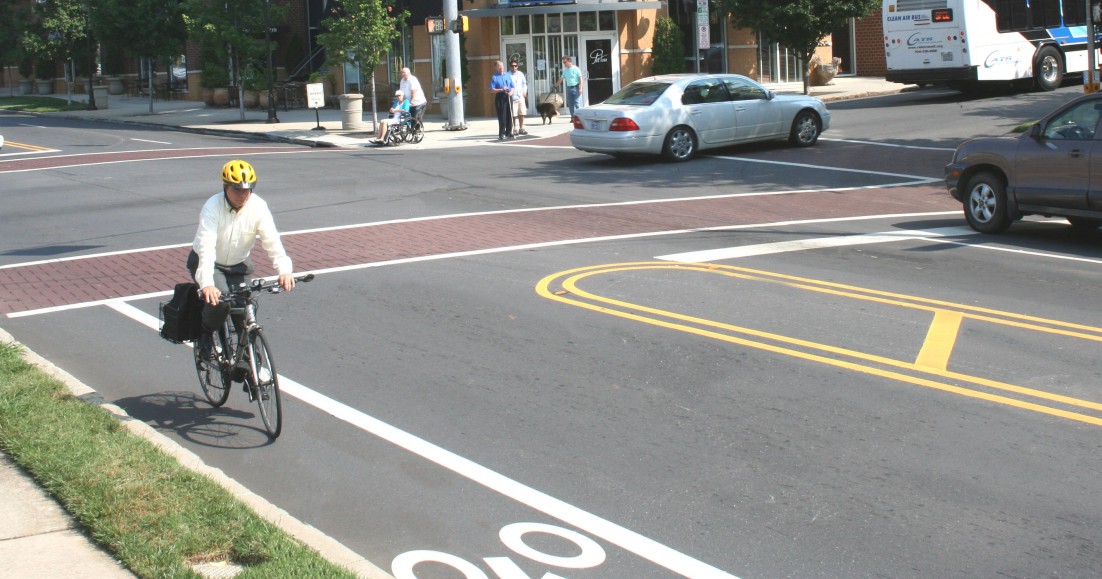Partnerships and Key Strategies
Expand Walking and Bicycling Network
NCDOT will work with public and private sector partners to improve the quality of transportation choice for pedestrian and bicycle travel throughout North Carolina by expanding and connecting the local, regional and intrastate network of bicycle facilities, supporting the expansion of community-oriented pedestrian facilities, providing better access to transit, and meeting the needs of the disabled in all project work. NCDOT, in partnership with local governments and the private sector, will work collaboratively to streamline pedestrian and bicycle project delivery through a multi-prong approach that focuses on identifying available funding, reducing encumbrances, and implementing the NCDOT Complete Streets Policy.
NCDOT will update the Division of Bicycle and Pedestrian Transportation planning grant program to modernize its function and purpose, create a new category of funding that supports Americans with Disabilities Act (ADA), and focus on corridor and small area grant awards.
NCDOT will work with colleges and universities to improve data, technology, and web applications that make planning and customer communication more efficient.
Finally, NCDOT and local partners will focus on land use and transportation integration. Cities will improve best practices and consider incentives for infill development and walkable/bikeable development.
THIS DIAGRAM REPRESENTS THE PARTNERSHIPS AND LEAD AGENCIES NECESSARY TO ADDRESS THIS PRINCIPLE.

Equity, choice, connectivity among transportation modes
| Objectives (The WHAT) |
| Expand and connect the local, regional and intrastate network of bicycle facilities |
Expand community-oriented pedestrian facilities |
Improve transportation equity (fairness in transportation choice and facilities across communities) |
Provide pedestrian and bicycle access to transit |
Reduce traffic congestion |
Improve performance-based program delivery |
Improve efficiency of technology and planning |
|
| Performance Measures (The EVALUATION) |
| Pedestrian and bicyclist mode share |
Percentage of trips made by bicycling and walking |
Percentage of non-controlled roadway mileage that has sidewalks |
Percentage of non-controlled roadway mileage that has designated and/or separated bicycle facilities |
Percentage of signalized intersections with pedestrian crosswalks and crossing signals |
Regions/MPOs/RPOs/Counties/Municipalities with bicycle/pedestrian/greenway plans |
Percentage of eligible roadway projects built as Complete Streets |
Percentage of transit, rail and ferry hubs with complete access amenities for bike/ped |
Percentage of state bike routes with paved shoulders |
Customer pedestrian and bicycle counts |
|
| Example Strategies (The HOW) |
| Increase investment in walking and biking infrastructure |
Streamline project planning and delivery |
Complete Streets implementation |
- Update Roadway Design Manual and Bicycle/Pedestrian Facility Design Guidelines
- Pass Complete Streets as law
|
Enhance transit access policies and design to make transit accessible, attractive, and safe for pedestrians and bicyclists |
Update NCDOT's Bicycle and Pedestrian Transportation planning grant program |
- modernize its function and purpose
- create a new category of funding that supports Americans with Disabilities Act (ADA)
- focus on corridor and small area grant awards
|
Partner with the League of American Bicyclists to improve the Bicycle Friendly State Program ranking |
- Annual evaluations and response to successful and unsuccessful programs appropriately to ensure sustainable future investments
|
Establish an evaluation/benchmarking program |
Partner with colleges, universities, and others to improve data development and technology |
|
Find out more about the 5 Pillars of the Plan






